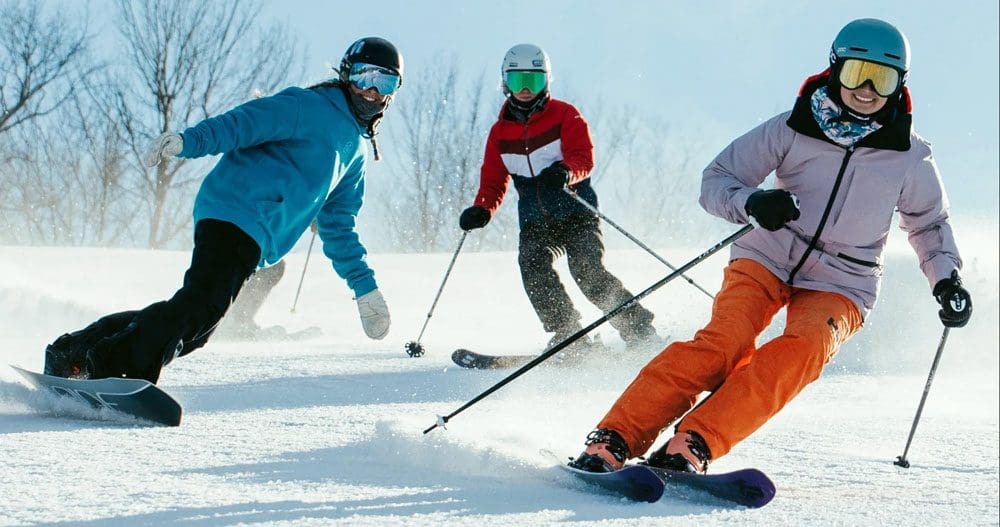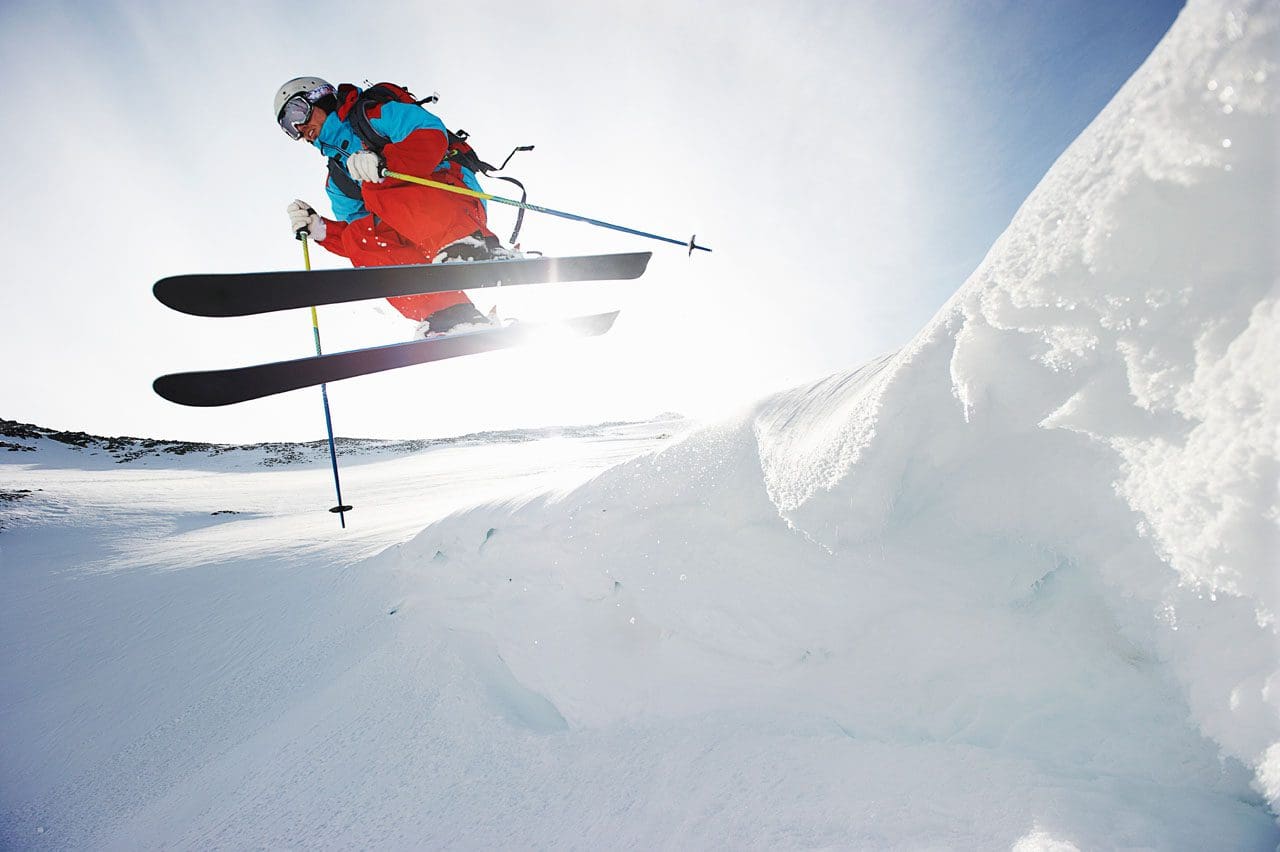Skiing sports require balance, strength, endurance, and muscle power. It is recommended to start training for ski season about eight to twelve weeks before heading to the slopes. However, any amount of training is better than no training; as long as you stay consistent and focus on exercises that enhance skiing or snowboarding, even a few weeks of fitness training can make a difference. A ski conditioning workout can help you ski better, stay out longer, prevent injuries, and have more fun.
Table of Contents
Skiing
Before beginning any training plan, check with your doctor or a certified training professional. The recommended strategy is a cardio and strength workout routine that trains and strengthens the lower-body muscles, including the quads, hamstrings, and glutes. This will improve mobility and balance to help control the skis better and support body parts like the knees, which are more prone to skiing injuries.
General Overview of Training
Increase Muscle Power
- Strengthen the quads, glutes, hamstrings, and hips.
Posture and Balance
- Train the core and the muscles around the hips, which helps provide stability.
Increase Endurance
- Condition the body to handle vigorous conditions.
Increase Cardiovascular Function
- Cardiovascular activities include running, biking, or interval training to strengthen the lungs and heart.
Training Schedule
Starting
- With skiing, you’ll need a combination of cardio and strength training and enhanced aerobic fitness for the higher altitude.
- Individuals are encouraged to start around six to eight weeks before ski season because it takes around that amount of time to experience the benefits.
- The muscles need time to recover and repair themselves between sessions.
- As aforementioned, you can still exercise even if you have missed the training window.
Cardio
- Cardio increases lung capacity and heart rate.
- The best cardio exercises for getting into ski shape work the entire body.
- Pick an enjoyable activity: jogging, biking, and high-intensity interval training/HITT.
- The goal should be 30 minutes of cardio activity 2-3 times a week to prepare the heart and lungs for downhill runs.
Recommended workouts for getting into ski shape:
- Elliptical trainer – The elliptical trainer is highly recommended for ski training, as it mimics the same upper-body and lower-body movements used in Nordic skiing.
- Stair climber
- Running
Other recommended workouts:
- Biking
- Jumping jacks
- High-intensity interval training (HITT)
Strength Training
Recommended strength training exercises will help with the following:
- Leg strength
- Lower body strength
- Core muscle strength
- Balance
- Endurance
- Muscle power
Keep the following in mind:
- Make the exercises fit your body.
- Move at your own pace.
- If something hurts or doesn’t feel right, modify the activity or skip it.
- Increase the number of sets or add more resistance/weight as the training progresses.
Warm-up:
- Start the workout with five to 10 minutes of easy cardio activity.
- This could be a short session on a treadmill, jumping jacks, or a quick jog.
Guidelines as you progress through the workout:
- Inhale during initial exertion, and exhale as you return to the starting position.
- Maintain breathing patterns during faster exercises.
- Rest at the end of each exercise.
Walking Lunge with Rotation Exercise
This exercise works the glutes, quads, hamstrings, and abdominals and improves core rotation.
- Stand with your feet slightly apart.
- Step one foot forward into a lunge.
- As you step forward, rotate your body to the side in the direction of your lead knee.
- Arms should be at chest height, slightly elevated from the sides.
- Drive up and through your forward leg to take the next lunge.
- Repeat ten times on each side for a total of 20.
Tips and modifications:
- If you don’t have enough space, you can stay in one spot and alternate lunging.
- Make it easier by keeping the back leg straight.
- Make sure that your knees do not go inward.
- Stay in a straight line with your foot and hip.
Lateral Ski Jump Exercise
This power exercise prepares for the explosive ski movements and energy bursts needed to control the descent.
- Stand with your feet hip-width apart and knees slightly bent, balancing on one leg.
- Jump to the side, landing on the other leg.
- Think about landing softly with your knee slightly bent.
- Jump to the other side, landing softly on the other leg.
- Swing the arms sideways across your body like a speed skater.
- Repeat 15 on each side.
Tips and modifications:
- Make smaller jumps to the side
- Move slower
- Touch your toe to the ground instead of keeping it off the floor.
Chop Exercise
This exercise will strengthen the core to initiate turns using the core rather than the arms or shoulders and help prevent lower back pain.
- Use a resistance band that you can secure slightly above the shoulders.
- Stand sideways to where the band is anchored.
- Position yourself so that you can reach up evenly with your shoulder to grab the free end of the band with both hands.
- Your knees should be slightly bent.
- Pull the band down across your body while turning your body.
- Think about the trunk doing most of the work for this exercise, not the arms and shoulders.
- Keep your arms as straight as you can as you pull the band down
- The arms should act as guides, with the obliques and back muscles generating the pulling and rotating power.
- Do this 15 times, then repeat facing the other way.
- Rest for 90 seconds before moving on to the next exercise.
Tips and modifications:
- Adjust the band resistance level by shortening it to increase resistance or lengthening it to ease resistance.
- The goal is to feel tired at the end of the reps but not so exhausted that you struggle to finish.
Hip Roll Exercise
This exercise strengthens the muscles of the hips, including the glutes, to help prevent knee pain. There’s a direct relationship between hip strength and knee control. When hip strength is weak, the knees tend to shift inward.
- Stand on your left leg.
- Lean your body forward at the hips, keeping the back straight.
- Lift your right leg back behind you, slightly off the ground.
- Rotate or roll your hip away from your standing foot.
- Maintain the body in a straight line as you roll your hips back.
- Repeat 10-15 times on each side.
Tips and modifications:
- If balancing is difficult, hold on to the back of a chair or keep your toes on the ground.
Whether you’re going alpine or Nordic skiing, these are just a few exercises designed to help all types and levels of recreational skiers and snowboarders. Always check with your doctor before starting any exercise routine, and it is recommended to consult a ski instructor or personal trainer for more comprehensive and intense workouts.
Ski Team Workout
References
Laskowski, E R. “Snow skiing.” Physical medicine and rehabilitation clinics of North America vol. 10,1 (1999): 189-211.
Nagle, Kyle B. “Cross-Country Skiing Injuries and Training Methods.” Current sports medicine reports vol. 14,6 (2015): 442-7. doi:10.1249/JSR.0000000000000205
Steadman, J R et al. “Training for Alpine skiing.” Clinical orthopedics and related research,216 (1987): 34-8.
Therell, Terese, et al. “Effects of Core Strength Training on Skiing Economy in Elite Junior Cross-Country Skiers.” Research quarterly for exercise and sport vol. 93,3 (2022): 608-614. doi:10.1080/02701367.2021.1887441
Post Disclaimer
Professional Scope of Practice *
The information herein on "Skiing Training: Chiropractic Functional Wellness Doctor Rx" is not intended to replace a one-on-one relationship with a qualified health care professional or licensed physician and is not medical advice. We encourage you to make healthcare decisions based on your research and partnership with a qualified healthcare professional.
Blog Information & Scope Discussions
Our information scope is limited to Chiropractic, musculoskeletal, physical medicines, wellness, contributing etiological viscerosomatic disturbances within clinical presentations, associated somatovisceral reflex clinical dynamics, subluxation complexes, sensitive health issues, and/or functional medicine articles, topics, and discussions.
We provide and present clinical collaboration with specialists from various disciplines. Each specialist is governed by their professional scope of practice and their jurisdiction of licensure. We use functional health & wellness protocols to treat and support care for the injuries or disorders of the musculoskeletal system.
Our videos, posts, topics, subjects, and insights cover clinical matters, issues, and topics that relate to and directly or indirectly support our clinical scope of practice.*
Our office has reasonably attempted to provide supportive citations and has identified the relevant research study or studies supporting our posts. We provide copies of supporting research studies available to regulatory boards and the public upon request.
We understand that we cover matters that require an additional explanation of how it may assist in a particular care plan or treatment protocol; therefore, to further discuss the subject matter above, please feel free to ask Dr. Alex Jimenez, DC, or contact us at 915-850-0900.
We are here to help you and your family.
Blessings
Dr. Alex Jimenez DC, MSACP, RN*, CCST, IFMCP*, CIFM*, ATN*
email: coach@elpasofunctionalmedicine.com
Licensed as a Doctor of Chiropractic (DC) in Texas & New Mexico*
Texas DC License # TX5807, New Mexico DC License # NM-DC2182
Licensed as a Registered Nurse (RN*) in Florida
Florida License RN License # RN9617241 (Control No. 3558029)
License Compact Status: Multi-State License: Authorized to Practice in 40 States*
Presently Matriculated: ICHS: MSN* FNP (Family Nurse Practitioner Program)
Dr. Alex Jimenez DC, MSACP, RN* CIFM*, IFMCP*, ATN*, CCST
My Digital Business Card


